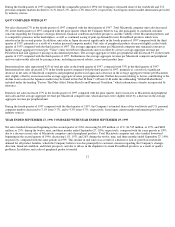Apple 1997 Annual Report Download - page 25
Download and view the complete annual report
Please find page 25 of the 1997 Apple annual report below. You can navigate through the pages in the report by either clicking on the pages listed below, or by using the keyword search tool below to find specific information within the annual report.availability and supply of product components to the Company, and ultimately the Company's consolidated results of operations.
When the U.S. dollar strengthens against other currencies, the U.S. dollar value of non-U.S. dollar-based sales decreases. When the U.S. dollar
weakens, the U.S. dollar value of non-U.S. dollar-based sales increases. Correspondingly, the U.S. dollar value of non-U.S. dollar-based costs
increases when the U.S. dollar weakens and decreases when the U.S. dollar strengthens. Overall, the Company is a net receiver of currencies
other than the U.S. dollar and, as such, benefits from a weaker dollar and is adversely affected by a stronger dollar relative to major currencies
worldwide. Accordingly, changes in exchange rates, and in particular a strengthening of the U.S. dollar, may negatively affect the Company's
consolidated sales and gross margins (as expressed in U.S. dollars).
While the Company is exposed with respect to fluctuations in the interest rates of many of the world's leading industrialized countries, the
Company's interest income and expense is most sensitive to fluctuations in the general level of U.S. interest rates. In this regard, changes in
U.S. interest rates affect the interest earned on the Company's cash, cash equivalents, and short-term investments as well as costs associated
with foreign currency hedges. To mitigate the impact of fluctuations in U.S. interest rates, the Company has entered into interest rate swap,
collar, and floor transactions.
To ensure the adequacy and effectiveness of the Company's foreign exchange and interest rate hedge positions, as well as to monitor the risks
and opportunities of the nonhedge portfolios, the Company continually monitors its foreign exchange forward and option positions, and its
interest rate swap, option and floor positions both on a stand-alone basis and in conjunction with its underlying foreign currency- and interest
rate-related exposures, respectively, from both an accounting and an economic perspective. However, given the effective horizons of the
Company's risk management activities, there can be no assurance that the aforementioned programs will offset more than a portion of the
adverse financial impact resulting from unfavorable movements in either foreign exchange or interest rates. In addition, the timing of the
accounting for recognition of gains and losses related to mark-to-market instruments for any given period may not coincide with the timing of
gains and losses related to the underlying economic exposures and, therefore, may adversely affect the Company's consolidated operating
results and financial position. The Company does not engage in leveraged hedging.
The Company's current financial condition may increase the costs of its hedging transactions, as well as affect the nature of the hedging
transactions into which the Company's counterparties are willing to enter.
Additional information regarding the Company's foreign exchange and interest rate risk management programs and the accounting thereon,
may be found in Part II, Item 8 of this Form 10-K in the Notes to Consolidated Financial Statements.
INVENTORY AND SUPPLY
The Company makes a provision for inventories of products that have become obsolete or are in excess of anticipated demand, accrues for any
cancellation fees of orders for inventories that have been canceled, and accrues for the estimated costs to correct any product quality problems.
Although the Company believes its inventory and related provisions are adequate given the rapid and unpredictable pace of product
obsolescence in the computer industry, no assurance can be given that the Company will not incur additional inventory and related charges. In
addition, such charges have had, and may again have, a material effect on the Company's consolidated financial position and results of
operations.
The Company must order components for its products and build inventory well in advance of product shipments. Because the Company's
markets are volatile and subject to rapid technology and price changes, there is a risk that the Company will forecast incorrectly and produce
excess or insufficient inventories of particular products. The Company's consolidated operating results and financial condition have been in
22
























